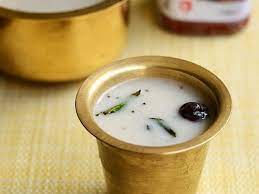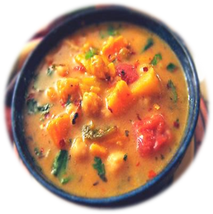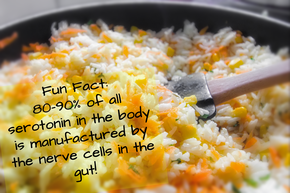 Kanjee is such a universal soup in India. I’ve seen it dressed up in many ways but the most nourishing for me is when it is very simple and used medicinally. I know that in Ayurvedic spas and hospitals this is a staple because it is so gentle on the digestive system and can help us detox and rejuvenate. This recipe comes from Kate O’Donnell. This version works as a light meal or snack. This also works as a cleanse or to keep you nourished while fasting. 1 cup barley, soaked overnight 10 cups water ½ tsp salt 1 tsp each ground cumin, turmeric, ginger ½ tsp black pepper In a large pot over low heat, boil barley, water salt, spices and pepper. Do this for one hour with the top partially covered until the grain breaks up and the soup appears creamy. Serve warm. Consider garnishing with chopped cilantro. Enjoy!
0 Comments
 I discovered this particular recipe just this year. I’ve tweaked it some but got it from the brilliant and sassy health coach, Andrea Beaman. I love how these tart little Vitamin C-packed cranberries mix so well with these powerful immune-supporting herbs. What I also adore about this recipe is that its from scratch and helps to heal the traumatic memories of that gelatinous crap from the can that always served as a repulsive centerpiece in my family’s winter holiday meals. You know what I'm talking about! This will make your home smell incredibly delicious and festive to boot! Enjoy this vitamin C-rich, anti-viral herb-infused goodness. Dazzle your guests with a truly authentic but simple cranberry sauce.  The more I witness the subtle and profound shifts in clients after a gratitude practice, the more curious I am about what “the experts” know regarding gratitude’s effect on our overall mental, emotional, physical health. There’s some exciting notions creeping into the scientific community regarding this topic! 1. PTSD & Post-Traumatic Growth: In a study conducted in 2006, researchers found that Viet Nam veterans suffering from PTSD had significantly less gratitude in their perspectives on life than veterans in a control group. That said, when asked to participate in daily journaling exercises eliciting gratitude, those with PTSD has a significant improvement in their daily outlook! (Kashdan, Uswatte, and Julian (2006)). A study measuring VIA traits (Values In Action) of people before and after the 9-11 attacks showed that gratitude was one characteristic that increased during this time period aiding in higher daily functioning (Peterson & Seligman, 2003). 2. Healing from Mental and Physical Ailments: A large study (2087 =n) in 2002-2003 showed that those who recovered from psychological or physical ailments had higher levels of gratitude (esp. appreciation of beauty, creativity, gratitude, bravery, spirituality, and love of learning) than those who had not (Peterson & Seligman, 203). 3. Better Sleep: A study comparing those with insomnia to those with regular sleep behavior, showed that higher gratitude correlated with better sleep quality and quantity (Nelson & Harvey, 2003).  Spicy African Yam Soup: Serves 8 One of the things I love about food and cooking is how it can help us connect (or stay connected) to the natural rhythm of life. With the change of seasons, we get to see a different list of fresh ingredients in the market, bringing our awareness to the changes in nature-- things getting quieter, cooler, our bodies seeking heartier, denser food to prepare for the coming of winter. Anytime we can bring our focus to a deeper connection to the natural world around us, there exists the invitation to remember that we are not alone and that there is more going on than our singular dramas and preoccupations. Food is a simple way to call us back to the bigger picture and to comfort us on so many levels of our being! Try this hearty, healthy stew to light the internal fires on a cold night!  For thousands of years in India and other parts of Asia, turmeric has been respected as an almost miracle spice. Held as a medicinal cure-all in many Eastern traditions this unique beverage has been used for a variety of conditions and afflictions. The West has started to acknowledge many of its benefits, thus it is becoming a trendy alternative the “mom’s chicken noodle soup.” Enjoy this recipe to soothe and balance the mind and body. Let its warmth, sweetness, and spice give you comfort on cold nights or bothersome days.  Changing seasons, holidays, politics, pandemics… what doesn’t create flux and a little chaos in our lives right now? It’s important to remember, whatever is cluttering our minds presently can also have an effect on our bodies. The gastrointestinal tract is especially susceptible to our stress levels and actually plays a role in our mental health. When we get stressed we signal the release of stress hormones and increase immune system activity. If this happens chronically, we can end up with inflammation in the body which wreaks havoc on our gut flora. This can become a vicious cycle since, if the gut flora is compromised, we can get invading species of bacteria or a general imbalance of gut flora. If this happens, the invading species can upregulate the production and release of those same stress hormones and keep the immune system in high alert… you see where I am going? Gut flora imbalances have been linked to a myriad of mental health concerns such as ADHA and depression. 1 |
AuthorDesert-Dwelling, Life-Loving, Globe-Trotting, Food-Adoring, Yoga Educator, Health Coach. Passionate, affirming, intuitive listener and guide for those seeking more health and happiness in their own Journey! Archives
April 2022
Categories
|
 RSS Feed
RSS Feed